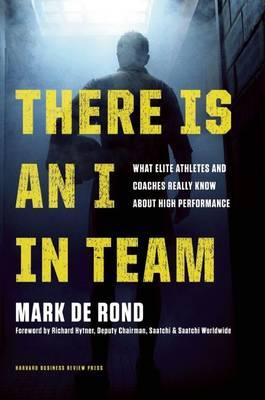A Response to WSJ’s “How to Get People to Work Together”
 Last Friday, just as I was about to close up shop for the weekend, I noticed a new article posted on The Wall Street Journal’s Careers section: “How to Get People to Work Together.” The piece was a brief interview with professor Mark de Rond, an organizational behavior scholar at the University of Cambridge’s Judge Business School, about his new book on teamwork, There Is an I in Team: What Elite Athletes and Coaches Really Know About High Performance.
Last Friday, just as I was about to close up shop for the weekend, I noticed a new article posted on The Wall Street Journal’s Careers section: “How to Get People to Work Together.” The piece was a brief interview with professor Mark de Rond, an organizational behavior scholar at the University of Cambridge’s Judge Business School, about his new book on teamwork, There Is an I in Team: What Elite Athletes and Coaches Really Know About High Performance.
I was pleased to see Professor De Rond bring his considerable academic weight to support many of my beliefs regarding what makes teams strong, effective and productive: the importance of developing and retaining top talent and creating work environments that minimize fear, to name a few.
However, there were parts of this article which rubbed me the wrong way. Take a look at the following excerpts, as well as quotes by Professor De Rond:
“The book also inveighs against team-building exercises like taking staffers to obstacle courses or on whitewater-rafting outings, which De Rond says are a waste of time and don’t help build trust among teammates. De Rond’s studies take him into the inner workings of different teams, including Cambridge’s famous rowing crew and a squad of combat doctors in an Afghanistan field hospital…”
“…‘I live with people literally, in extreme environments, to try to figure out how they can work together when the s— hits the fan. It’s difficult, but I love to do it…’
‘…The priority for managers is not necessarily to engage in social activity or to bring in consultants to get people to walk over hot coals; it’s the importance of building an environment that allows people to speak out without fear.’…”
As someone who specializes in NYC corporate team building activities, over the past 3 years I, too, have worked with people in extreme environments – not in war zones, perhaps, but certainly among those who have been impacted most directly by the economic meltdown, especially within the financial sector. I have seen teams at their lowest: layoffs, furloughs, pay freezes/cuts, increased workloads, stress, fear, uncertainty, horrible office morale and much more, all providing a grim backdrop to the daily grind faced by company employees, managers and owners alike.
Believe it or not, I actually agree with Professor De Rond’s sentiments about team building, as well as his research approach. Scientific study of group performance SHOULD be done of teams who thrive under extreme conditions; and team building activities should not be a meaningless waste of time, as so many regrettably tend to be.
But what about team bonding activities which DO produce desired results, and promote strong, effective teams? There is an argument not reflected in this article that when highly customized for the individual strengths and weaknesses of a group, team building events can foster an environment which reinforces positive teamwork skills – communication, collaboration, group decision making, conflict resolution etc. – while at the same time reducing workplace fears. When combined with an appropriate social element, these activities can be extremely beneficial for developing teams which work better together, are happier and, most importantly, produce more efficient, higher quality work.
I’ve seen it with my own eyes, and believe this to my core: positive shared experiences DO lead to lasting team improvement, provided they are done in a smart, sensitive and meaningful way.
What do you think? Please feel free to share your reactions below!